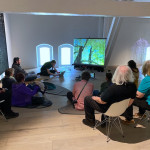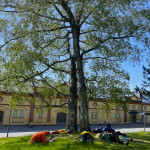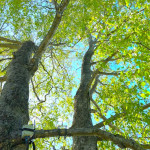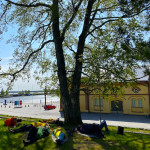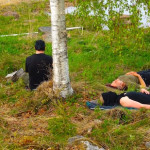- Kuntsi Art Museum in Vaasa, May 27, 2023
We all know how plants turn towards the light so they can better absorb the sun’s energy. But how do they do it? They have neither a nervous system nor a brain.
This project offers an opportunity to meet Per Huttner and Karine Bonneval who come to the Kuntsi art museum in May to talk about their working process and to show how they develop a platform for communication between trees and people. During the last year, they have worked together to reshape scientific tools so so that they can be used to create new and exciting artistic expressions. In other words, they have turned the technology that scientists use to study the internal communication of trees into artistic tools. They use sound to transform the trees’ internal signals into something that people listen to and look at and that has artistic qualities. At the same time, the artists allow signals from people’s brains to create sounds that are played to the roots of the trees, the part most sensitive to oscillations of this type.
The artists are in Ostrobothnia to experiment with the signals they receive from trees and how these can be used to create interesting sounds in real time. Because each artist has a unique and individual working method, we will be able to see how the signals can be used in several different ways. The work mainly takes place in the forest, but if the weather conditions are difficult, we can also work indoors with a signal from a tree nearby or a recorded signal from trees.
In their working process the artists focus primarily on trees’ and their inner signalling. They use the PepiPIAF technology to measure changes in the trees. This non-invasive technology is attached to a branch of a tree. It measures the changes in pressure and temperature inside the actual tree, based on how sap moves. It shows how a tree adapts itself to changes of temperature, season, and daily rhythm. From these measurements we can derive information about how the tree grows and to a certain degree how it adapts to outside changes. You can find more info about the PepiPIAF here. (In French only.)
The work thus forms a platform for people and trees to interact. The artists start from research in biology that has recently shown how plants perceive the world and solve problems. To “perceive the world” in this context, means that a plant senses how its surroundings change (e.g. light, soil, water and/or heat conditions). To “solve problems,” means that when a plant’s external conditions change, they react in different ways that increase their probability of survival. That plants take in information about the outside world and can respond to changed conditions, means that they have a form of internal communication, an internal “language.
The project is supported by Svenska kulturfonden, Helge Ax:son Johnsons stiftelse and Kulturbryggan.

